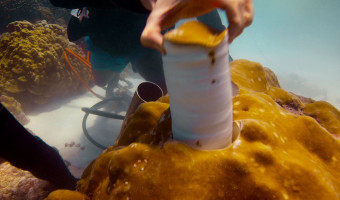
LESSON SUMMARY
Students will use the stories in episode three to better understand the how both climate change and El Niño weather patterns affect coral ecosystems.
LEARNING OBJECTIVES
- Students will examine evidence and sources of evidence to draw conclusions and make predictions.
- Students will examine sea surface temperature and sea surface temperature anomalies around Christmas Island
- Students will consider the impacts of sea surface temperature on corals and analyze trends over time.
- Students will analyze how both climate change and El Niño weather patterns affect coral ecosystems.
TEACHER BACKGROUND
Climate change is among the greatest threats to coral reef ecosystems worldwide. As seas surface temperatures rise due to climate change, coral bleaching and disease events will occur more often and be more severe. At the same time, carbon emissions from fossil fuel burning are being absorbed by the oceans, causing the ocean waters to become more acidic. The global impacts on oceans are compounded by local environmental degradation from pollution, over use, over fishing, and other human activities.
Bleaching occurs when the colorful algae that corals need to survive become toxic and are expelled, turning the coral white. For milder bleaching events, the algae and coral can recover within a few weeks or months. But, severe bleaching events can kill the coral and have devastating impacts on the marine ecosystems they support. Even a small increase in the sea surface temperature (0.5-1.5° C) over several weeks or a large temperature increase (3-4° C) over a few days can lead to bleaching. Solar irradiance (exposure to the sun’s ultraviolet rays), pollution, reef exploitation, and ocean acidification can also lead to bleaching.
The oceans have absorbed about a quarter of the carbon emitted to the atmosphere by burning fossil fuels (half has remained in the atmosphere and the rest has gone into the terrestrial biosphere, mostly forests). The removal of some of the excess carbon from the atmosphere has slowed the pace of global warming. But adding carbon to the oceans is also causing them to become acidic, which makes it difficult for corals and other marine life to form shells and exoskeletons. From the mid-1700s to the 1990s, the sea surface pH decrease from 8.25 to around 8.14. Ocean pH levels are expected to drop even further by 2100 as carbon dioxide emissions continue.
Lesson Videos
Lessons
Stories HS-3: The Scientist & Rising Tide
In “The Scientist: Christmas Island,” M. Sanjayan of The Nature Conservancy dives with scientist Kim Cobb to the bottom of the South Pacific looking for answers hidden in fossil corals. In “Rising Tide: Tottenville,” correspondent Chris Hayes follows Congressman Michael Grimm for a year to see what he can do for the residents of Staten Island after Superstorm Sandy.
Materials HS-3

For this lesson, students will need their science notebooks and one-to-one or paired use of computer with internet and access to Google Earth. Please provide students with the following handouts: NOAA Coral Reef Watch Data Set Methodology, A Look Inside Scientific Articles, and Analyzing Coral Thermal Stress using NOAA’s Coral Watch Monitoring System in Google Earth.
Vocabulary HS-3

Anomaly, climate, climate change, correlation, credible, currents, drought, El Niño, La Niña emissions, evidence, fact, greenhouse gases, impact, local v. global, natural cycle, opinion, oscillation, paleoclimatology, qualitative data, quantitative data, sea surface temperature, thermal stress, science, trade winds, trend line, weather
Prerequisite Knowledge HS-3
Length: 15 minutes

Have students take the Pre-Quiz. This will allow you to see the knowledge your students have prior to watching episode 3.
Engage HS-3
Length: 30 minutes

Go to NOAA’s Coral Reef Watch: Satellite Coral Bleaching Monitoring Datasets page. Download the most recent package for Google Earth. Since episode 3 deals with the birthplace of El Niño events, that will be the location students will analyze.
Explore HS-3
Length: 30 minutes

Watch episode 3. As students watch each segment have them stop and answer each of the questions below in their science notebook. At the conclusion of all segments, encourage students to add to or modify their thinking.
Explain HS-3
Length: 75 minutes

Students are now going to do a more thorough analysis of the datasets within NOAA’s Coral Reef Watch within Google Earth.
Elaborate HS-3

Allow students to choose one of the following articles to read. Provide students with the directions for diving deeper into their reading and the rubric (Scientific Articles Handout).
Evaluate HS-3

The interactive online quiz provides instant feedback about your knowledge of this subject. The justified true/false questions are meant for use in the classrooms.
Taking Action and Designing Solutions HS-3

Taking actions and/or designing solutions to our local, national, and global problems are a personal journey. Via Facebook and Twitter (#YEARSproject), share how you are taking action to combat climate change or if you’ve designed potential solutions share those on Instagram or make a Vine.
Writer’s Corner HS-3

Without language there is no science. To be practicing scientists and derive new knowledge, we need language – reading, writing, talking, listening, enacting, and visualizing. Writing is one way to communicate understanding of our learning while allowing us to be creative in our delivery and provide insight and possible solutions to problems.
Agents of Change HS-3

Kim Cobb, PhD, is Associate professor in the School of Earth and Atmospheric Sciences at the Georgia Institute of Technology.
Careers HS-3

Inspired by Episode 3? Thinking about your future? You have the power to make a difference today and in the future. Look into careers inspired by the issues presented in Episode 3: The Surge.
Resources and Links HS-3

Bell, Gerald. “Climate Diagnostic Bulletin: March 2014.” U.S. Department of Commerce, 2014. Wed. 28 Apr. 2014. Climate Prediction Center. Publications: Monthly Climate Diagnostics Bulletin. Wed. 28 Apr. 2014. http://www.cpc.ncep.noaa.gov/products/outreach/publications.shtml. “Climate at a Glance.” National Climatic Data Center (NCDC). N.p., n.d. Web. 15 Apr. 2014. http://www.ncdc.noaa.gov/cag/. Coral Bleaching. http://www.noaawatch.gov/themes/coral_bleaching.php Department of Labor Statistics. http://www.bls.gov/ooh/home.htm El Niño […]
Standards HS-3

Download the standards tables for High School Lesson 3: NGSS, CCSS, and NCSS. You can also read the different standards applicable to High School Lesson 3 here.
PDF Lesson Plan HS-3

Download the printable PDF Lesson Plan for Lesson 3.

